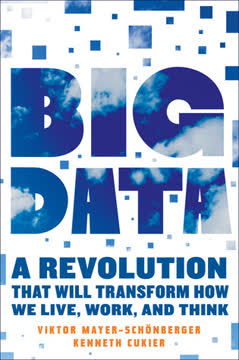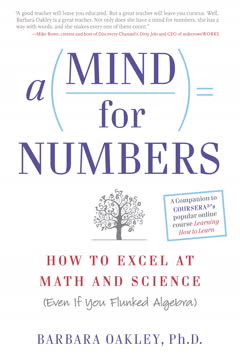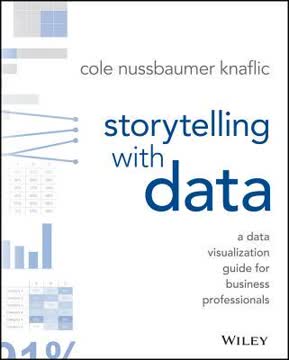Key Takeaways
1. Data Analytics: A Cycle of Continuous Improvement
Any business organization needs to continually monitor its business environment and its own performance, and then rapidly adjust its future plans.
The BIDM Cycle. Data analytics is not a one-time event but a continuous cycle. Businesses record activities, analyze the resulting data, generate insights, and then feed those insights back into the business to improve effectiveness and efficiency. This cycle, known as the Business Intelligence and Data Mining (BIDM) cycle, ensures that the business is constantly evolving and adapting to better serve customer needs.
Data-Driven Evolution. The BIDM cycle emphasizes the importance of data-based decision-making. By analyzing data, businesses can identify patterns and trends that would otherwise remain hidden. These insights can then be used to make informed decisions about product development, marketing strategies, and operational improvements.
Real-World Application. Consider a retail chain that analyzes sales data to identify fast-selling items, regional preferences, and seasonal trends. This information can then be used to optimize product placement, design targeted promotions, and improve store layouts, leading to a better-performing business. The cycle continues as the business monitors the results of these changes and makes further adjustments based on the new data.
2. Business Intelligence: Informed Decision-Making
Business intelligence is a broad set of information technology (IT) solutions that includes tools for gathering, analyzing, and reporting information to the users about performance of the organization and its environment.
IT Solutions for Insight. Business intelligence (BI) encompasses a range of IT tools and techniques designed to gather, analyze, and report information about an organization's performance and its environment. These tools help managers make better decisions by providing them with up-to-date metrics and insights. BI solutions are among the most highly prioritized solutions for investment.
Strategic and Operational Decisions. BI can improve both strategic and operational decision-making. Strategic decisions, which impact the direction of the company, can be informed by what-if analyses and data-mined patterns. Operational decisions, focused on efficiency, can be automated using data-based models.
Real-Time Adaptation. Effective BI has an evolutionary component, as business models evolve. By generating fresh insights in real-time, businesses can make better decisions and gain a significant competitive advantage. This requires a constant feedback loop where new data is analyzed, models are revised, and insights are incorporated into operating procedures.
3. Pattern Recognition: Unveiling Hidden Connections
A pattern is a design or model that helps grasp something.
Simplifying Complexity. Pattern recognition is the process of identifying designs or models that help connect seemingly unrelated things. Patterns cut through complexity and reveal simpler, understandable trends. These patterns can be temporal, spatial, or functional.
Types of Patterns.
- Temporal: Regular occurrences over time (e.g., "some people are always late").
- Spatial: Organization in a certain way (e.g., the top 20% of customers generate 80% of the business).
- Functional: Certain actions lead to certain effects (e.g., some students excel in essay questions, others in multiple-choice).
Data Mining for Patterns. Data mining is like diamond mining, digging into large amounts of raw data to discover unique, useful patterns. A skilled data miner knows what kinds of patterns to look for and understands the business domain well. A systematic approach to mining data is necessary to efficiently reveal valuable insights.
4. Data Warehousing: Centralized Data for Analysis
A data warehouse is an organized store of data from all over the organization, specially designed to help make management decisions.
Organized Data Store. A data warehouse (DW) is an organized collection of integrated, subject-oriented databases designed to support decision support functions. It provides clean, enterprise-wide data in a standardized format for reports, queries, and analysis. DW is physically and functionally separate from an operational and transactional database.
Design Considerations.
- Subject-oriented: Designed around a subject domain.
- Integrated: Includes data from many functions.
- Time-variant: Data grows at regular intervals.
- Nonvolatile: Persistent and consistently available.
- Summarized: Rolled-up data at the right level.
- Not normalized: Uses a star schema for speed.
- Metadata: Well-defined and documented elements.
Benefits of Data Warehousing. DW supports business reporting and data mining activities. It facilitates distributed access to up-to-date business knowledge, improving business efficiency and customer service. DW enables a consolidated view of corporate data, providing better and timely information.
5. Data Mining: Discovering Actionable Insights
Data Mining is the art and science of discovering useful innovative patterns from data.
Extracting Useful Patterns. Data mining is the process of extracting useful patterns from an organized collection of data. Patterns must be valid, novel, potentially useful, and understandable. The implicit assumption is that data about the past can reveal patterns of activity that can be projected into the future.
Data Mining Techniques.
- Decision Trees: Classify populations into classes.
- Regression: Find a best-fitting curve through data points.
- Artificial Neural Networks: Learn from past data and predict future values.
- Cluster Analysis: Divide data sets into clusters.
- Association Rule Mining: Look for associations between data values.
Selecting Data Mining Projects. Data mining should be done to solve high-priority, high-value problems. It requires effort to gather, clean, organize, and mine data. It is important that there be a large expected payoff from finding the insight.
6. Data Visualization: Communicating Complex Data
Data Visualization is the art and science of making data easy to understand and consume, for the end user.
Making Data Accessible. Data visualization is the art and science of making data easy to understand and consume for the end user. It involves showing the right amount of data, in the right order, in the right visual form, to convey high-priority information. The right visualization requires an understanding of the consumer’s needs, the nature of the data, and the available tools and techniques.
Types of Charts.
- Line graph: Shows data as a series of points connected by line segments.
- Scatter plot: Reveals the relationship between two variables.
- Bar graph: Shows rectangular bars with lengths proportional to values.
- Pie charts: Shows the distribution of a variable.
- Geographical Data maps: Denotes statistics on maps.
Tips for Data Visualization. Present conclusions, not just data. Choose charts wisely. Organize results to make the central point stand out. Ensure visuals accurately reflect the numbers. Make the presentation unique, imaginative, and memorable.
7. Decision Trees: Classifying and Predicting Outcomes
Decision trees are a simple way to guide one’s path to a decision.
Guiding Decisions. Decision trees are a simple way to guide one's path to a decision. They are hierarchically branched structures that help one come to a decision based on asking certain questions in a particular sequence. Decision trees are one of the most widely used techniques for classification.
Decision Tree Construction. A decision tree is constructed by asking the more important questions first and the less important questions later. The most important question is the one that gives the most insight about the situation. The variable that leads to the least number of errors should be chosen as the first node.
Benefits of Decision Trees.
- Easy to understand and use.
- Select the most relevant variables automatically.
- Tolerant of data quality issues.
- Handle non-linear relationships well.
8. Regression: Modeling Relationships and Forecasting
Regression is a well-known statistical technique to model the predictive relationship between several independent variables (DVs) and one dependent variable.
Predictive Relationships. Regression is a statistical technique to model the predictive relationship between several independent variables and one dependent variable. The objective is to find the best-fitting curve for a dependent variable in a multidimensional space. The quality of fit is measured by a coefficient of correlation.
Visualizing Relationships. A scatter plot is a simple exercise for plotting data points between two variables on a graph. It provides a visual layout of where all the data points are placed in that two-dimensional space. The scatter plot can be useful for graphically intuiting the relationship between two variables.
Regression Equation. The regression model is described as a linear equation: y = β0 + β1x + ε, where y is the dependent variable, x is the independent variable, β0 and β1 are the constant and coefficient, and ε is the random error variable. Regression models can be linear or non-linear.
9. Cluster Analysis: Segmenting Data into Groups
Cluster analysis is used for automatic identification of natural groupings of things.
Automatic Grouping. Cluster analysis is used for automatic identification of natural groupings of things. Data instances that are similar to each other are categorized into one cluster, while data instances that are very different from each other are moved into different clusters. Clustering is also known as the segmentation technique.
Applications of Cluster Analysis.
- Market Segmentation: Categorizing customers according to their similarities.
- Product portfolio: Grouping people of similar sizes for clothing items.
- Text Mining: Organizing text documents according to content similarities.
K-Means Algorithm. K-means is the most popular clustering algorithm. It iteratively computes the clusters and their centroids. It is a top-down approach to clustering. The K-means technique is a popular technique and allows the user guidance in selecting the right number (K) of clusters from the data.
10. Association Rule Mining: Uncovering Relationships
Associate rule mining is a popular, unsupervised learning technique, used in business to help identify shopping patterns.
Market Basket Analysis. Associate rule mining is a technique used in business to help identify shopping patterns. It is also known as market basket analysis. It helps find interesting relationships (affinities) between variables (items or events).
Representing Association Rules. A generic Association Rule is represented between a set X and Y: X → Y [S%, C%], where X and Y are products or services, S is support, and C is confidence. Support is how often X and Y go together, and confidence is how often Y is found, given X.
Apriori Algorithm. This is the most popular algorithm used for association rule mining. The objective is to find subsets that are common to at least a minimum number of the itemsets. A frequent itemset is an itemset whose support is greater than or equal to minimum support threshold.
11. Text Mining: Extracting Knowledge from Text
Text mining is the art and science of discovering knowledge, insights and patterns from an organized collection of textual databases.
Discovering Insights. Text mining is the process of discovering knowledge, insights, and patterns from an organized collection of textual databases. It can help with frequency analysis of important terms and their semantic relationships. Text mining can be applied to large-scale social media data for gathering preferences and measuring emotional sentiments.
Text Mining Process.
- Gather text and documents into a corpus.
- Analyze the corpus for structure.
- Analyze the structured data for word structures, sequences, and frequency.
Term Document Matrix. Free-flowing text can be transformed into numeric data in a Term Document Matrix (TDM), which can then be mined using regular data mining techniques. The TDM measures the frequencies of select important terms occurring in each document.
12. Big Data: Managing and Benefitting from Massive Datasets
Big Data is an all-inclusive term that refers to extremely large, very fast, highly diverse, and complex data that cannot be managed with traditional data management tools.
Defining Big Data. Big Data refers to extremely large, very fast, highly diverse, and complex data that cannot be managed with traditional data management tools. It includes all kinds of data and helps deliver the right information to the right person at the right time to help make the right decisions.
The 4 Vs of Big Data.
- Volume: The quantity of data.
- Velocity: The speed of data generation and transmission.
- Variety: The forms and functions of data.
- Veracity: The truthfulness, believability, and quality of data.
Technology Challenges. The major technological challenges in managing Big Data are storing huge volumes, ingesting streams at an extremely fast pace, handling a variety of forms and functions of data, and processing data at huge speeds. These challenges are addressed by technologies such as Hadoop, Spark, and NoSQL databases.
Last updated:
Review Summary
Data Analytics Made Accessible receives mixed reviews, with an average rating of 3.75/5. Many readers appreciate its comprehensive overview of data analytics concepts, accessible language, and practical examples. The book is praised for its structure, including case studies and exercises. However, some criticize its brevity in certain chapters and occasional grammatical errors. It's considered an excellent introduction for beginners and non-technical readers, but may be too basic for those with prior experience. Overall, readers find it a valuable resource for understanding data analytics fundamentals.
Similar Books










Download PDF
Download EPUB
.epub digital book format is ideal for reading ebooks on phones, tablets, and e-readers.




